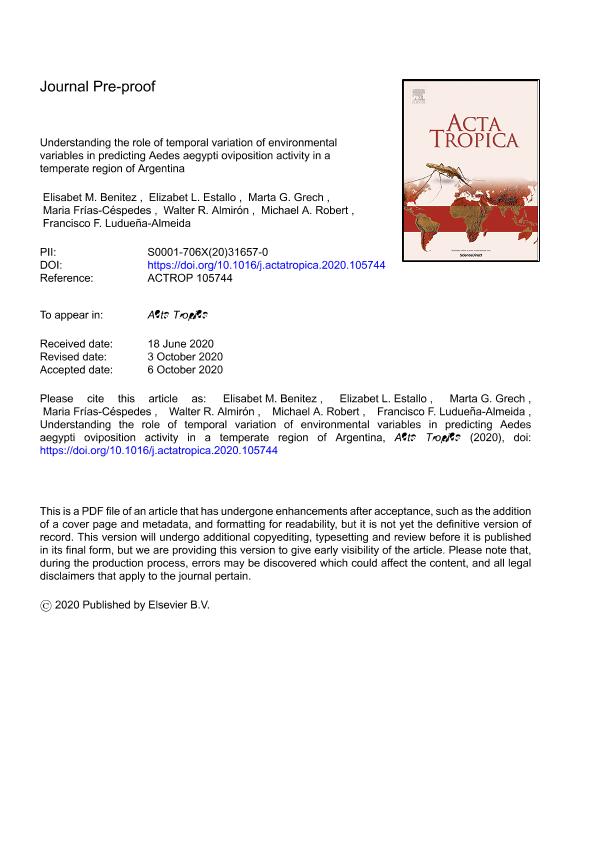Artículo
Understanding the role of temporal variation of environmental variables in predicting Aedes aegypti oviposition activity in a temperate region of Argentina
Benitez, Elisabet Marina ; Estallo, Elizabet Lilia
; Estallo, Elizabet Lilia ; Grech, Marta Gladys
; Grech, Marta Gladys ; Frías Céspedes, Maria; Almiron, Walter Ricardo
; Frías Céspedes, Maria; Almiron, Walter Ricardo ; Robert, Michael A.; Ludueña Almeida, Francisco
; Robert, Michael A.; Ludueña Almeida, Francisco
 ; Estallo, Elizabet Lilia
; Estallo, Elizabet Lilia ; Grech, Marta Gladys
; Grech, Marta Gladys ; Frías Céspedes, Maria; Almiron, Walter Ricardo
; Frías Céspedes, Maria; Almiron, Walter Ricardo ; Robert, Michael A.; Ludueña Almeida, Francisco
; Robert, Michael A.; Ludueña Almeida, Francisco
Fecha de publicación:
04/2021
Editorial:
Elsevier Science
Revista:
Acta Tropica
ISSN:
0001-706X
Idioma:
Inglés
Tipo de recurso:
Artículo publicado
Clasificación temática:
Resumen
Environmental variables related to vegetation and weather are some of the most influential factors that impacting Aedes (Stegomya) aegypti, a mosquito vector of dengue, chikungunya and Zika viruses. In this paper, we aim to develop temporal predictive models for Ae. aegypti oviposition activity utilizing vegetation and meteorological variables as predictors in Córdoba city (Argentina). Eggs were collected using ovitraps placed throughout the city from 2009 to 2012 that were replaced weekly. Temporal generalized linear mixed models were developed with negative binomial distributions of errors that model average number of eggs collected weekly as a function of vegetation and meteorological variables with time lags. The best model included a vegetation index, vapor pressure of water, precipitation and photoperiod. With each unit of increment in vegetation index per week the average number of eggs increased by 1.71 in the third week. Furthermore, each millimeter increase of accumulated rain during 4 weeks was associated with a decrease of 0.668 in the average number of eggs found in the following week. This negative effect of precipitation could occur during abundant rainfalls that fill containers completely, thereby depriving females of oviposition sites and leading them to search for other suitable breeding sites. Furthermore, the average number of eggs increased with the photoperiod at low values of mean vapor pressure; however the average number of eggs decreased at high values of mean vapor pressure, and the positive relationship between the response variable and mean vapor pressure was stronger at low values of photoperiod. Additionally, minimum temperature was associated positively with oviposition activity and that low minimum temperatures could be a limiting factor in Ae. aegypti oviposition activity. Our results emphasize the important role that climatic variables such as temperature, precipitation, and vapor pressure play in Ae. aegypti oviposition activity and how these variables along with vegetation indices can be used to inform predictive temporal models of Ae. aegypti population dynamics that can be used for informing mosquito population control and arbovirus mitigation strategies.
Archivos asociados
Licencia
Identificadores
Colecciones
Articulos(IIBYT)
Articulos de INSTITUTO DE INVESTIGACIONES BIOLOGICAS Y TECNOLOGICAS
Articulos de INSTITUTO DE INVESTIGACIONES BIOLOGICAS Y TECNOLOGICAS
Citación
Benitez, Elisabet Marina; Estallo, Elizabet Lilia; Grech, Marta Gladys; Frías Céspedes, Maria; Almiron, Walter Ricardo; et al.; Understanding the role of temporal variation of environmental variables in predicting Aedes aegypti oviposition activity in a temperate region of Argentina; Elsevier Science; Acta Tropica; 216; 105744; 4-2021; 1-41
Compartir
Altmétricas



